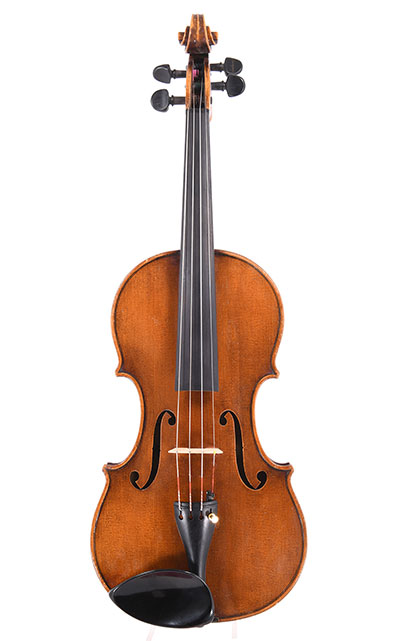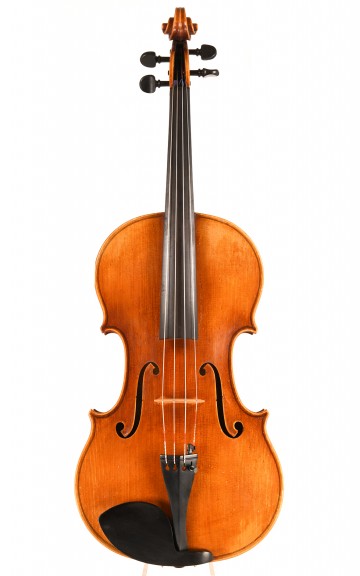Bubenreuth as the “new” Schönbach
A luthier memorialised in two different places: Elias Placht has a contemplative air on the two monuments created in his honour. In each, he is studying the violin in his hands with such intensity that it might seem as if his mind were somewhere else altogether – perhaps in the Czech town of Luby (Schönbach), where documents record him as the town’s first luthier in 1927, or in the Franconian town of Bubenreuth in Germany, where a replica of the Schönbach monument to him was unveiled in 1969.
Content overview:
- Bubenreuth as the “new” Schönbach
- From a farm village to an industrial town
- Successful new and re-established businesses in Bubenreuth
- A crisis in Bubenreuth’s instrument industry
The two monuments, which lie around 200 km miles apart, are separated by the German-Czech border, the former Iron Curtain, and about halfway between these two points in time, 1927 and 1969, the event occurred that linked the two together: after WWII, German instrument makers were displaced from the Bohemian region, and as a consequence, a village near Erlangen, Germany, became a globally active site of industrial production.
From a farm village to an industrial town
Before the luthiers of Schönbach came to stay, the village of Bubenreuth had no more than 700 inhabitants, and other than agriculture it had no business activity of its own. The people of Bubenreuth were farmers or travelled to nearby Erlangen to work. After the migration, 400 new apartments were created for some 1,600 new inhabitants within only a few years to accommodate those who very suddenly arrived and industrialised the rural region. The backstory to this transition involved Schönbach’s instrument makers and their interest in upholding a well-established model of cooperation that had been in practice for generations. For it to continue, the displaced people to re-settle together. Since the late 18th century, the Bohemian part of the Vogtland region had maintained a distribution of labour, a “home-industrial“ production system in which many small- to mid-sized workshops worked jointly to produce plucked and bowed string instruments. To sell their instruments, they were largely dependent on the influential merchants in the Saxonian town of Markneukirchen, who at the zenith of this development were supplying hundreds of thousands of Schönbach instruments throughout the world every year, reaching destinations as far away as the US.
This approach to business was thus intended to revive the parts of Bavaria which had poor infrastructure and had been weakened by the war. It would breathe new life into the region, which was why in October 1945 the Bavarian state government commissioned guitar maker Fred Wilfer to prepare all of the prerequisites needed to help Schönbach citizens re-settle in the Erlangen region. This decision was made after Mittenwald, a town with a rich tradition of violin making, had been ruled out as a venue due to the vehement resistance from the luthiers there.
Successful new and re-established businesses in Bubenreuth
On 1 January 1946, the internationally renowned FRAMUS was founded, Wilfer’s Fränkischer Musikinstrumentenerzeugung Fred Wilfer KG (Franconian musical instrument production limited partnership, Fred Wilfer), and it represented more than simply a new business opening. FRAMUS laid the cornerstone for the entire music industry in Bubenreuth, and over time it attracted entrepreneurs such as Albert Roth, who re-founded his expropriated Markneukirchen workshop Ernst Heinrich Roth in Bubenreuth in 1953. Such businesses created a ripple effect and led to a network of smaller independent workshops which all focused on artisanal craftsmanship at high standards.
 The fact that guitar making quickly caught up with violin making, which had initially dominated the scene, is a phenomenon that is due less to the economic influence of FRAMUS than to a development in the international music market in the 1950s and especially in the 1960s. The new residents of Bubenreuth realized how they could take advantage of this growth and link it to the successes of their previous work in Schönbach; in their new home, they created nothing less than the most important and most effectively internationally networked centre of western German instrument making. It is an interesting twist of fate that this meant they could act freely and were no longer dependent on a dominant trade area such as Markneukirchen.
The fact that guitar making quickly caught up with violin making, which had initially dominated the scene, is a phenomenon that is due less to the economic influence of FRAMUS than to a development in the international music market in the 1950s and especially in the 1960s. The new residents of Bubenreuth realized how they could take advantage of this growth and link it to the successes of their previous work in Schönbach; in their new home, they created nothing less than the most important and most effectively internationally networked centre of western German instrument making. It is an interesting twist of fate that this meant they could act freely and were no longer dependent on a dominant trade area such as Markneukirchen.
A crisis in Bubenreuth’s instrument industry
Their period of growth did not last long, however: by the 1970s, the influence of increased competition on the world market brought about the bankruptcy of FRAMUS and a gradual decimation of the musical instrument industry in the central Franconian region. With their orientation towards western countries, Bubenreuth guitar makers long underestimated the rise of Japanese manufacturers at first and then later the Chinese violin makers as a new global source of stringed instruments. This pattern emerged in a very similar fashion to the way it had happened in the 19th century in the Bohemian-Saxonian region of Vogtland where the people of Bubenreuth were from.
Today, little remains of what was once a booming business in Bubenreuth, although the regional yellow pages are still well-filled with listings for instrument makers – particularly for a town of fewer than 5,000 – and include many well-known names from the Saxonian-Bohemian tradition such as Raabs, Roth, Sandner, Schuster and Seifert. Whereas some 1800 people were employed in the Bubenreuth musical instrument industry at its heyday, now there are only some 200. However, the relatively low unemployment figures show that the region has apparently succeeded in re-defining itself once again.




